harmony 鸿蒙Freezing a Custom Component
Freezing a Custom Component
When a custom component decorated by @ComponentV2 is inactive, it can be frozen so that its state variable does not respond to updates. That is, the @Monitor decorated method is not called, and the node associated with the state variable is not re-rendered. You can use the freezeWhenInactive attribute to specify whether to freeze a custom component. If no parameter is passed in, the feature is disabled. This feature works in following scenarios: page routing, TabContent, and Navigation.
Before reading this topic, you are advised to read \@ComponentV2.
NOTE
Freezing of @ComponentV2 decorated custom component is supported since API version 12.
Mixed use of custom component freezing is supported since API version 18.
Different from freezing the @Component decorated components, custom components decorated by @ComponentV2 do not support freezing the cached list items in the LazyForEach scenario.
Use Scenarios
Page Routing
NOTE
This example uses router for page redirection but you are advised to use the Navigation component instead, because Navigation provides more functions and more flexible customization capabilities. For details, see the use cases of Navigation.
- When page 1 calls the router.pushUrl API to jump to page 2, page 1 is hidden and invisible. In this case, if the state variable on page 1 is updated, page 1 is not re-rendered. For details, see the following.
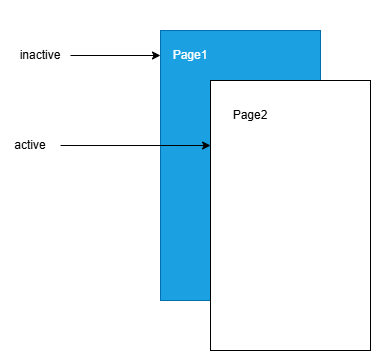
Page 1
import { router } from '@kit.ArkUI';
@ObservedV2
export class Book {
@Trace name: string = "100";
constructor(page: string) {
this.name = page;
}
}
@Entry
@ComponentV2({ freezeWhenInactive: true })
export struct Page1 {
@Local bookTest: Book = new Book("A Midsummer Night's Dream");
@Monitor("bookTest.name")
onMessageChange(monitor: IMonitor) {
console.log(`The book name change from ${monitor.value()?.before} to ${monitor.value()?.now}`);
}
build() {
Column() {
Text(`Book name is ${this.bookTest.name}`).fontSize(25)
Button('changeBookName').fontSize(25)
.onClick(() => {
this.bookTest.name = "The Old Man and the Sea";
})
Button('go to next page').fontSize(25)
.onClick(() => {
router.pushUrl({ url: 'pages/Page2' });
setTimeout(() => {
this.bookTest = new Book("Jane Austen oPride and Prejudice");
}, 1000)
})
}
}
}
Page 2
import { router } from '@kit.ArkUI';
@Entry
@ComponentV2
struct Page2 {
build() {
Column() {
Text(`This is the page2`).fontSize(25)
Button('Back')
.onClick(() => {
router.back();
})
}
}
}
In the preceding example:
Click the changeBookName button on page 1. The name attribute of the bookTest variable is changed, and the onMessageChange method registered in @Monitor is called.
Click the go to next page button on page 1 to redirect to page 2, and then update the state variable bookTest 1s later. When bookTest is updated, page 2 is displayed and Page 1 is in the inactive state. The state variable @Local bookTest does not respond to the update. Therefore, the @Monitor is not called, and the node associated with the state variable is not updated. The trace diagram is as follows.
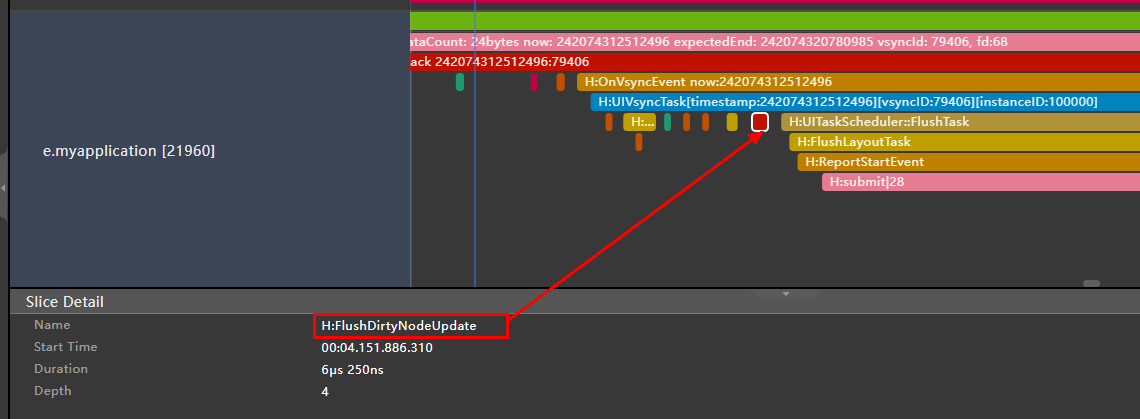
- Click Back. Page 2 is destroyed, and the state of page 1 changes from inactive to active. The update of the state variable bookTest is observed, the onMessageChange method registered in @Monitor is called, and the corresponding text content is changed.
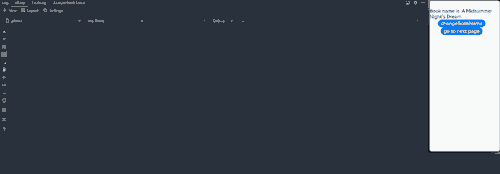
TabContent
You can freeze invisible TabContent components in the Tabs container so that they do not trigger UI re-rendering.
During initial rendering, only the TabContent component that is being displayed is created. All TabContent components are created only after all of them have been switched to.
For details, see the following.
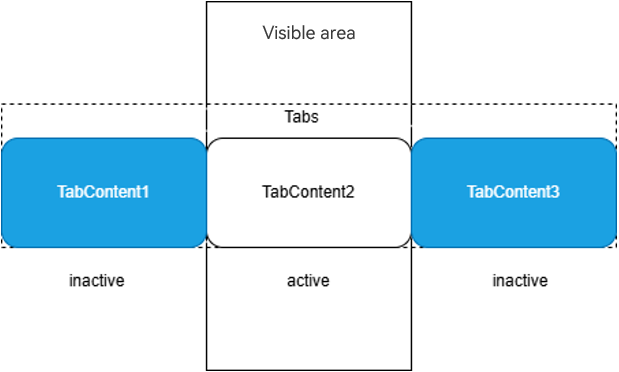
@Entry
@ComponentV2
struct TabContentTest {
@Local message: number = 0;
@Local data: number[] = [0, 1];
build() {
Row() {
Column() {
Button('change message').onClick(() => {
this.message++;
})
Tabs() {
ForEach(this.data, (item: number) => {
TabContent() {
FreezeChild({ message: this.message, index: item })
}.tabBar(`tab${item}`)
}, (item: number) => item.toString())
}
}
.width('100%')
}
.height('100%')
}
}
@ComponentV2({ freezeWhenInactive: true })
struct FreezeChild {
@Param message: number = 0;
@Param index: number = 0;
@Monitor('message') onMessageUpdated(mon: IMonitor) {
console.info(`FreezeChild message callback func ${this.message}, index: ${this.index}`);
}
build() {
Text("message" + `${this.message}, index: ${this.index}`)
.fontSize(50)
.fontWeight(FontWeight.Bold)
}
}
In the preceding example:
When change message is clicked, the value of message changes, and the @Monitor decorated onMessageUpdated method of the TabContent component being displayed is called.
When tab1 in TabBar is clicked to switch to another TabContent component, the component switches from inactive to active, and the corresponding @Monitor decorated onMessageUpdated method is called.
When change message is clicked again, the value of message changes, and only the @Monitor decorated onMessageUpdated method of the TabContent component being displayed is called. Other inactive TabContent components do not trigger @Monitor.
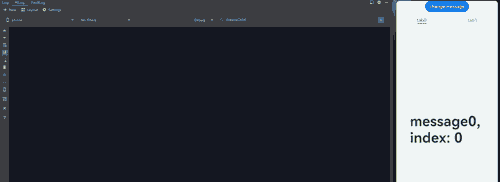
Navigation
- When the navigation destination page is invisible, its child custom components are set to the inactive state and will not be re-rendered. When return to this page, its child custom components are restored to the active state and the @Monitor callback is triggered to re-render the page.
@Entry
@ComponentV2
struct MyNavigationTestStack {
@Provider('pageInfo') pageInfo: NavPathStack = new NavPathStack();
@Local message: number = 0;
@Monitor('message') info() {
console.info(`freeze-test MyNavigation message callback ${this.message}`);
}
@Builder
PageMap(name: string) {
if (name === 'pageOne') {
pageOneStack({ message: this.message })
} else if (name === 'pageTwo') {
pageTwoStack({ message: this.message })
} else if (name === 'pageThree') {
pageThreeStack({ message: this.message })
}
}
build() {
Column() {
Button('change message')
.onClick(() => {
this.message++;
})
Navigation(this.pageInfo) {
Column() {
Button('Next Page', { stateEffect: true, type: ButtonType.Capsule })
.onClick(() => {
this.pageInfo.pushPath({ name: 'pageOne' }); // Push the navigation destination page specified by name to the navigation stack.
})
}
}.title('NavIndex')
.navDestination(this.PageMap)
.mode(NavigationMode.Stack)
}
}
}
@ComponentV2
struct pageOneStack {
@Consumer('pageInfo') pageInfo: NavPathStack = new NavPathStack();
@Local index: number = 1;
@Param message: number = 0;
build() {
NavDestination() {
Column() {
NavigationContentMsgStack({ message: this.message, index: this.index })
Text("cur stack size:" + `${this.pageInfo.size()}`)
.fontSize(30)
Button('Next Page', { stateEffect: true, type: ButtonType.Capsule })
.onClick(() => {
this.pageInfo.pushPathByName('pageTwo', null);
})
Button('Back Page', { stateEffect: true, type: ButtonType.Capsule })
.onClick(() => {
this.pageInfo.pop();
})
}.width('100%').height('100%')
}.title('pageOne')
.onBackPressed(() => {
this.pageInfo.pop();
return true;
})
}
}
@ComponentV2
struct pageTwoStack {
@Consumer('pageInfo') pageInfo: NavPathStack = new NavPathStack();
@Local index: number = 2;
@Param message: number = 0;
build() {
NavDestination() {
Column() {
NavigationContentMsgStack({ message: this.message, index: this.index })
Text("cur stack size:" + `${this.pageInfo.size()}`)
.fontSize(30)
Button('Next Page', { stateEffect: true, type: ButtonType.Capsule })
.onClick(() => {
this.pageInfo.pushPathByName('pageThree', null);
})
Button('Back Page', { stateEffect: true, type: ButtonType.Capsule })
.onClick(() => {
this.pageInfo.pop();
})
}
}.title('pageTwo')
.onBackPressed(() => {
this.pageInfo.pop();
return true;
})
}
}
@ComponentV2
struct pageThreeStack {
@Consumer('pageInfo') pageInfo: NavPathStack = new NavPathStack();
@Local index: number = 3;
@Param message: number = 0;
build() {
NavDestination() {
Column() {
NavigationContentMsgStack({ message: this.message, index: this.index })
Text("cur stack size:" + `${this.pageInfo.size()}`)
.fontSize(30)
Button('Next Page', { stateEffect: true, type: ButtonType.Capsule })
.height(40)
.onClick(() => {
this.pageInfo.pushPathByName('pageOne', null);
})
Button('Back Page', { stateEffect: true, type: ButtonType.Capsule })
.height(40)
.onClick(() => {
this.pageInfo.pop();
})
}
}.title('pageThree')
.onBackPressed(() => {
this.pageInfo.pop();
return true;
})
}
}
@ComponentV2({ freezeWhenInactive: true })
struct NavigationContentMsgStack {
@Param message: number = 0;
@Param index: number = 0;
@Monitor('message') info() {
console.info(`freeze-test NavigationContent message callback ${this.message}`);
console.info(`freeze-test ---- called by content ${this.index}`);
}
build() {
Column() {
Text("msg:" + `${this.message}`)
.fontSize(30)
}
}
}
In the preceding example:
When change message is clicked, the value of message changes, and the @Monitor decorated info method of the MyNavigationTestStack component being displayed is called.
When Next Page is clicked, the page is switched to PageOne and the pageOneStack node is created.
When change message is clicked again, the value of message changes, and only the @Monitor decorated info method of the NavigationContentMsgStack child component in pageOneStack is called.
When Next Page is clicked, the page is switched to PageTwo and the pageTwoStack node is created. The state of the pageOneStack node changes from active to inactive.
When change message is clicked again, the value of message changes, and only the @Monitor decorated info method of the NavigationContentMsgStack child component in pageTwoStack is called. The child custom component in NavDestination that is not at the top of the navigation routing stack is in the inactive state. The @Monitor method is not triggered.
When Next Page is clicked, the page is switched to PageThree and the pageThreeStack node is created. The state of the pageTwoStack node changes from active to inactive.
When change message is clicked again, the value of message changes, and only the @Monitor decorated info method of the NavigationContentMsgStack child component in pageThreeStack is called. The child custom component in NavDestination that is not at the top of the navigation routing stack is in the inactive state. The @Monitor method is not triggered.
Click Back Page to return to PageTwo. The state of the pageTwoStack node changes from inactive to active, and the info method registered in @Monitor of the NavigationContentMsgStack child component is triggered.
Click Back Page again to return to PageOne. The state of the pageOneStack node changes from inactive to active, and the info method registered in @Monitor of the NavigationContentMsgStack child component is triggered.
When Back Page is clicked, the page is switched to the initial page.

Repeat virtualScroll
NOTE
Repeat virtualScroll supports custom component freezing since API version 18.
Freeze the custom components in the Repeat virtualScroll cache pool to avoid unnecessary component re-renders. You are advised to read Child Component Rendering Logic of virtualScroll in advance.
@Entry
@ComponentV2
struct RepeatVirtualScrollFreeze {
@Local simpleList: Array<string> = [];
@Local bgColor: Color = Color.Pink;
aboutToAppear(): void {
for (let i = 0; i < 7; i++) {
this.simpleList.push(`item${i}`);
}
}
build() {
Column() {
Row() {
Button(`Reduce length to 5`)
.onClick(() => {
this.simpleList = this.simpleList.slice(0, 5);
})
Button(`Change bgColor`)
.onClick(() => {
this.bgColor = this.bgColor == Color.Pink ? Color.Blue : Color.Pink;
})
}
List() {
Repeat(this.simpleList)
.each((obj: RepeatItem<string>) => {
})
.key((item: string, index: number) => item)
.virtualScroll({ totalCount: this.simpleList.length })
.templateId(() => `a`)
.template(`a`, (ri) => {
ChildComponent({
message: ri.item,
bgColor: this.bgColor
})
}, { cachedCount: 2 })
}
.cachedCount(0)
.height(500)
}
.height(`100%`)
}
}
// Enable component freezing.
@ComponentV2({ freezeWhenInactive: true })
struct ChildComponent {
@Param @Require message: string = ``;
@Param @Require bgColor: Color = Color.Pink;
@Monitor(`bgColor`)
onBgColorChange(monitor: IMonitor) {
// When the bgColor changes, the components in the cache pool are not re-rendered and no log is printed.
console.log(`repeat---bgColor change from ${monitor.value()?.before} to ${monitor.value()?.now}`);
}
build() {
Text(`[a]: ${this.message}`)
.fontSize(50)
.backgroundColor(this.bgColor)
}
}
In the preceding example:
After you click Reduce length to 5, the two removed components enter the Repeat cache pool. Then, click Change bgColor to change the value of bgColor to trigger node re-rendering.
If freezeWhenInactive is set to true, only the onBgColorChange method decorated by @Monitor in the remaining nodes is triggered. In the example, the five nodes are re-rendered and five logs are printed. The nodes in the cache pool are not re-rendered.
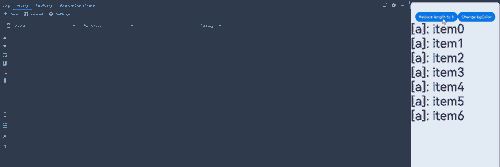
// Disable component freezing.
@ComponentV2({ freezeWhenInactive: false })
struct ChildComponent {
@Param @Require message: string = ``;
@Param @Require bgColor: Color = Color.Pink;
@Monitor(`bgColor`)
onBgColorChange(monitor: IMonitor) {
// When the bgColor changes, components in the cache pool are re-rendered and logs are printed.
console.log(`repeat---bgColor change from ${monitor.value()?.before} to ${monitor.value()?.now}`);
}
build() {
Text(`[a]: ${this.message}`)
.fontSize(50)
.backgroundColor(this.bgColor)
}
}
freezeWhenInactive is set to false to disable component freezing. If freezeWhenInactive is not specified, component freezing is disabled by default. The onBgColorChange method decorated by @Monitor in the remaining nodes and cache pool nodes is triggered, that is, seven nodes are re-rendered and seven logs are printed.
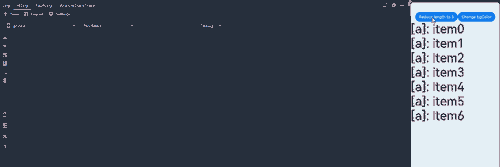
Mixed Use of Component Freezing
In the scenario where mixed use of component freezing is supported, the freezing behavior varies according to the API version. Set the component freezing flag for the parent component. In API version 17 or earlier, when the parent component is unfrozen, all nodes of its child components are unfrozen. Since API version 18, when the parent component is unfrozen, only the on-screen nodes of the child component are unfrozen. For details, see Mixing the Use of Components.
Mixing Use of Navigation and TabContent
@ComponentV2
struct ChildOfParamComponent {
@Require @Param child_val: number;
@Monitor('child_val') onChange(m: IMonitor) {
console.log(`Appmonitor ChildOfParamComponent: changed ${m.dirty[0]}: ${m.value()?.before} -> ${m.value()?.now}`);
}
build() {
Column() {
Text(`Child Param: ${this.child_val}`);
}
}
}
@ComponentV2
struct ParamComponent {
@Require @Param val: number;
@Monitor('val') onChange(m: IMonitor) {
console.log(`Appmonitor ParamComponent: changed ${m.dirty[0]}: ${m.value()?.before} -> ${m.value()?.now}`);
}
build() {
Column() {
Text(`val: ${this.val}`);
ChildOfParamComponent({child_val: this.val});
}
}
}
@ComponentV2
struct DelayComponent {
@Require @Param delayVal1: number;
@Monitor('delayVal1') onChange(m: IMonitor) {
console.log(`Appmonitor DelayComponent: changed ${m.dirty[0]}: ${m.value()?.before} -> ${m.value()?.now}`);
}
build() {
Column() {
Text(`Delay Param: ${this.delayVal1}`);
}
}
}
@ComponentV2 ({freezeWhenInactive: true})
struct TabsComponent {
private controller: TabsController = new TabsController();
@Local tabState: number = 47;
@Monitor('tabState') onChange(m: IMonitor) {
console.log(`Appmonitor TabsComponent: changed ${m.dirty[0]}: ${m.value()?.before} -> ${m.value()?.now}`);
}
build() {
Column({space: 10}) {
Button(`Incr state ${this.tabState}`)
.fontSize(25)
.onClick(() => {
console.log('Button increment state value');
this.tabState = this.tabState + 1;
})
Tabs({ barPosition: BarPosition.Start, index: 0, controller: this.controller}) {
TabContent() {
ParamComponent({val: this.tabState});
}.tabBar('Update')
TabContent() {
DelayComponent({delayVal1: this.tabState});
}.tabBar('DelayUpdate')
}
.vertical(false)
.scrollable(true)
.barMode(BarMode.Fixed)
.barWidth(400).barHeight(150).animationDuration(400)
.width('100%')
.height(200)
.backgroundColor(0xF5F5F5)
}
}
}
@Entry
@Component
struct MyNavigationTestStack {
@Provide('pageInfo') pageInfo: NavPathStack = new NavPathStack();
@Builder
PageMap(name: string) {
if (name === 'pageOne') {
pageOneStack()
} else if (name === 'pageTwo') {
pageTwoStack()
}
}
build() {
Column() {
Navigation(this.pageInfo) {
Column() {
Button('Next Page', { stateEffect: true, type: ButtonType.Capsule })
.width('80%')
.height(40)
.margin(20)
.onClick(() => {
this.pageInfo.pushPath({ name: 'pageOne' }); // Push the navigation destination page specified by name to the navigation stack.
})
}
}.title('NavIndex')
.navDestination(this.PageMap)
.mode(NavigationMode.Stack)
}
}
}
@Component
struct pageOneStack {
@Consume('pageInfo') pageInfo: NavPathStack;
build() {
NavDestination() {
Column() {
TabsComponent();
Button('Next Page', { stateEffect: true, type: ButtonType.Capsule })
.width('80%')
.height(40)
.margin(20)
.onClick(() => {
this.pageInfo.pushPathByName('pageTwo', null);
})
}.width('100%').height('100%')
}.title('pageOne')
.onBackPressed(() => {
this.pageInfo.pop();
return true;
})
}
}
@Component
struct pageTwoStack {
@Consume('pageInfo') pageInfo: NavPathStack;
build() {
NavDestination() {
Column() {
Button('Back Page', { stateEffect: true, type: ButtonType.Capsule })
.width('80%')
.height(40)
.margin(20)
.onClick(() => {
this.pageInfo.pop();
})
}.width('100%').height('100%')
}.title('pageTwo')
.onBackPressed(() => {
this.pageInfo.pop();
return true;
})
}
}
For API version 17 or earlier:
Click Next page to enter the next page and then return to the previous page. All labels of Tabcontent are unfrozen.
For API version 18 or later:
Click Next page to enter the next page and then return to the previous page. Only the nodes with the corresponding labels are unfrozen.
Constraints
As shown in the following example, the custom node BuilderNode is used in FreezeBuildNode. BuilderNode can dynamically mount components using commands and component freezing strongly depends on the parent-child relationship to determine whether it is enabled. In this case, if the parent component is frozen and BuilderNode is enabled at the middle level of the component tree, the child component of the BuilderNode cannot be frozen.
import { BuilderNode, FrameNode, NodeController, UIContext } from '@kit.ArkUI';
// Define a Params class to pass parameters.
@ObservedV2
class Params {
// Singleton mode. Ensure that there is only one Params instance.
static singleton_: Params;
// Method for obtaining the Params instance.
static instance() {
if (!Params.singleton_) {
Params.singleton_ = new Params(0);
}
return Params.singleton_;
}
// Use the @Trace decorator to decorate the message attribute so that its changes are observable.
@Trace message: string = "Hello";
index: number = 0;
constructor(index: number) {
this.index = index;
}
}
// Define a buildNodeChild component that contains a message attribute and an index attribute.
@ComponentV2
struct buildNodeChild {
// Use the Params instance as the storage attribute.
storage: Params = Params.instance();
@Param index: number = 0;
// Use the @Monitor decorator to listen for the changes of storage.message.
@Monitor("storage.message")
onMessageChange(monitor: IMonitor) {
console.log(`FreezeBuildNode buildNodeChild message callback func ${this.storage.message}, index:${this.index}`);
}
build() {
Text(`buildNode Child message: ${this.storage.message}`).fontSize(30)
}
}
// Define a buildText function that receives a Params parameter and constructs a Column component.
@Builder
function buildText(params: Params) {
Column() {
buildNodeChild({ index: params.index })
}
}
class TextNodeController extends NodeController {
private textNode: BuilderNode<[Params]>|null = null;
private index: number = 0;
// The constructor receives an index parameter.
constructor(index: number) {
super();
this.index = index;
}
// Create and return a FrameNode.
makeNode(context: UIContext): FrameNode|null {
this.textNode = new BuilderNode(context);
this.textNode.build(wrapBuilder<[Params]>(buildText), new Params(this.index));
return this.textNode.getFrameNode();
}
}
// Define an index component that contains a message attribute and a data array.
@Entry
@ComponentV2
struct Index {
// Use the Params instance as the storage attribute.
storage: Params = Params.instance();
private data: number[] = [0, 1];
build() {
Row() {
Column() {
Button("change").fontSize(30)
.onClick(() => {
this.storage.message += 'a';
})
Tabs() {
// Use Repeat to repeatedly render the TabContent component.
Repeat<number>(this.data)
.each((obj: RepeatItem<number>) => {
TabContent() {
FreezeBuildNode({ index: obj.item })
.margin({ top: 20 })
}.tabBar(`tab${obj.item}`)
})
.key((item: number) => item.toString())
}
}
}
.width('100%')
.height('100%')
}
}
// Define a FreezeBuildNode component that contains a message attribute and an index attribute.
@ComponentV2({ freezeWhenInactive: true })
struct FreezeBuildNode {
// Use the Params instance as the storage attribute.
storage: Params = Params.instance();
@Param index: number = 0;
// Use the @Monitor decorator to listen for the changes of storage.message.
@Monitor("storage.message")
onMessageChange(monitor: IMonitor) {
console.log(`FreezeBuildNode message callback func ${this.storage.message}, index: ${this.index}`);
}
build() {
NodeContainer(new TextNodeController(this.index))
.width('100%')
.height('100%')
.backgroundColor('#FFF0F0F0')
}
}
Click Button(“change”) to change the value of message. The onMessageUpdated method registered in @Watch of the TabContent component that is being displayed is triggered, and that under the BuilderNode node of TabContent that is not displayed is also triggered.
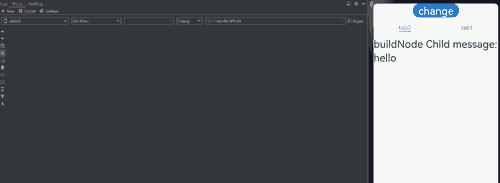
你可能感兴趣的鸿蒙文章
harmony 鸿蒙\@AnimatableExtend Decorator: Definition of Animatable Attributes
harmony 鸿蒙Application State Management Overview
harmony 鸿蒙AppStorage: Storing Application-wide UI State
harmony 鸿蒙Basic Syntax Overview
harmony 鸿蒙\@Builder Decorator: Custom Builder Function
harmony 鸿蒙\@BuilderParam Decorator: Referencing the \@Builder Function
harmony 鸿蒙Creating a Custom Component
harmony 鸿蒙Mixing Use of Custom Components
harmony 鸿蒙Constraints on Access Modifiers of Custom Component Member Variables
- 所属分类: 后端技术
- 本文标签:
热门推荐
-
2、 - 优质文章
-
3、 gate.io
-
7、 openharmony
-
9、 golang